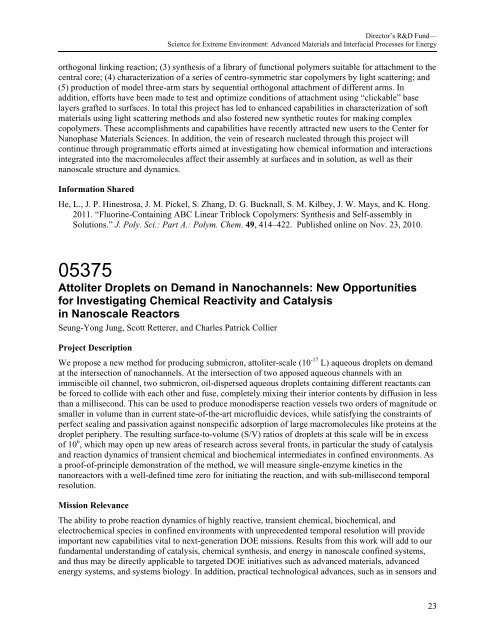FY2010 - Oak Ridge National Laboratory
FY2010 - Oak Ridge National Laboratory
FY2010 - Oak Ridge National Laboratory
You also want an ePaper? Increase the reach of your titles
YUMPU automatically turns print PDFs into web optimized ePapers that Google loves.
Director’s R&D Fund—<br />
Science for Extreme Environment: Advanced Materials and Interfacial Processes for Energy<br />
orthogonal linking reaction; (3) synthesis of a library of functional polymers suitable for attachment to the<br />
central core; (4) characterization of a series of centro-symmetric star copolymers by light scattering; and<br />
(5) production of model three-arm stars by sequential orthogonal attachment of different arms. In<br />
addition, efforts have been made to test and optimize conditions of attachment using “clickable” base<br />
layers grafted to surfaces. In total this project has led to enhanced capabilities in characterization of soft<br />
materials using light scattering methods and also fostered new synthetic routes for making complex<br />
copolymers. These accomplishments and capabilities have recently attracted new users to the Center for<br />
Nanophase Materials Sciences. In addition, the vein of research nucleated through this project will<br />
continue through programmatic efforts aimed at investigating how chemical information and interactions<br />
integrated into the macromolecules affect their assembly at surfaces and in solution, as well as their<br />
nanoscale structure and dynamics.<br />
Information Shared<br />
He, L., J. P. Hinestrosa, J. M. Pickel, S. Zhang, D. G. Bucknall, S. M. Kilbey, J. W. Mays, and K. Hong.<br />
2011. “Fluorine-Containing ABC Linear Triblock Copolymers: Synthesis and Self-assembly in<br />
Solutions.” J. Poly. Sci.: Part A.: Polym. Chem. 49, 414–422. Published online on Nov. 23, 2010.<br />
05375<br />
Attoliter Droplets on Demand in Nanochannels: New Opportunities<br />
for Investigating Chemical Reactivity and Catalysis<br />
in Nanoscale Reactors<br />
Seung-Yong Jung, Scott Retterer, and Charles Patrick Collier<br />
Project Description<br />
We propose a new method for producing submicron, attoliter-scale (10 -17 L) aqueous droplets on demand<br />
at the intersection of nanochannels. At the intersection of two apposed aqueous channels with an<br />
immiscible oil channel, two submicron, oil-dispersed aqueous droplets containing different reactants can<br />
be forced to collide with each other and fuse, completely mixing their interior contents by diffusion in less<br />
than a millisecond. This can be used to produce monodisperse reaction vessels two orders of magnitude or<br />
smaller in volume than in current state-of-the-art microfluidic devices, while satisfying the constraints of<br />
perfect sealing and passivation against nonspecific adsorption of large macromolecules like proteins at the<br />
droplet periphery. The resulting surface-to-volume (S/V) ratios of droplets at this scale will be in excess<br />
of 10 6 , which may open up new areas of research across several fronts, in particular the study of catalysis<br />
and reaction dynamics of transient chemical and biochemical intermediates in confined environments. As<br />
a proof-of-principle demonstration of the method, we will measure single-enzyme kinetics in the<br />
nanoreactors with a well-defined time zero for initiating the reaction, and with sub-millisecond temporal<br />
resolution.<br />
Mission Relevance<br />
The ability to probe reaction dynamics of highly reactive, transient chemical, biochemical, and<br />
electrochemical species in confined environments with unprecedented temporal resolution will provide<br />
important new capabilities vital to next-generation DOE missions. Results from this work will add to our<br />
fundamental understanding of catalysis, chemical synthesis, and energy in nanoscale confined systems,<br />
and thus may be directly applicable to targeted DOE initiatives such as advanced materials, advanced<br />
energy systems, and systems biology. In addition, practical technological advances, such as in sensors and<br />
23
















